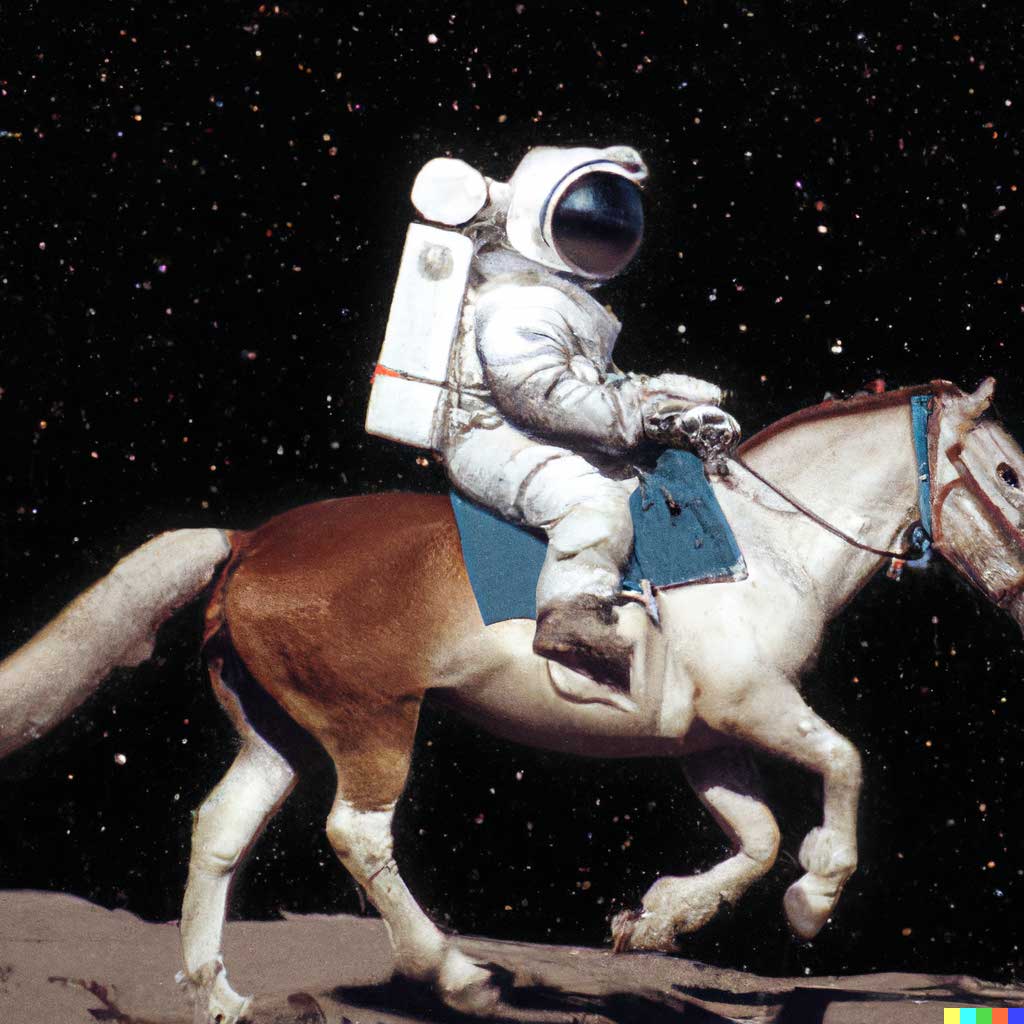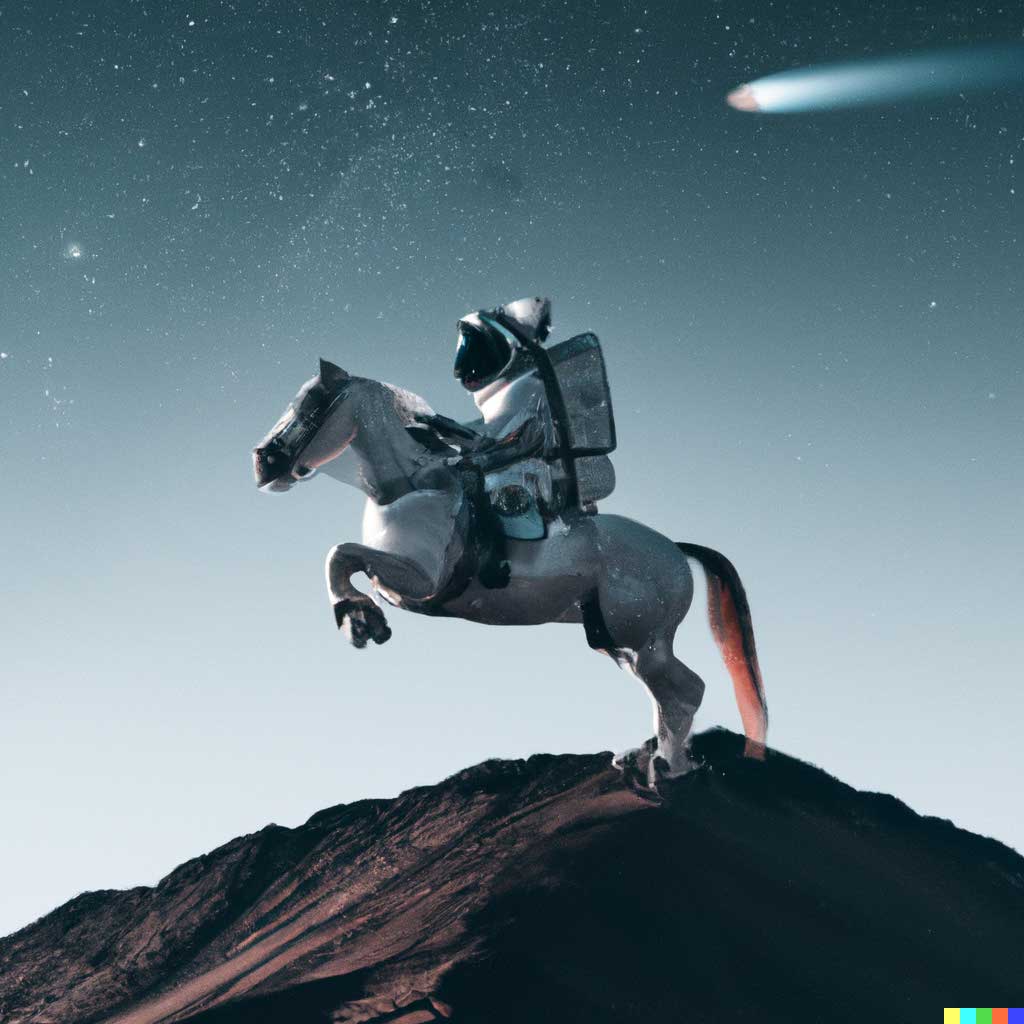I was preparing a presentation recently and I needed a very special image.
A dolphin image. But not in the ocean but in space,
so it has to be a dolphin in an astronaut suit.
Because it will be near the Saturn.
I know this is somewhat of a surreal request,
but this is what I needed for the presentation
Of course, when you type "A dolphin in an astronaut suit near Saturn"
in the search engines, nothing comes up,
you can't find anything. Even if you search in English.
What can we do to meet such a need then?
Can we ask the computer to make such a picture for us?
There was an artificial intelligence that I told you about last year, remember?
“An artificial intelligence that draws whatever you say!” I said.
It was able to fulfill even the most absurd requests such as “snail burger”.
Its new version was announced last week:
DALL-E 2.
This time it can draw much higher resolution and quality results in a much shorter time.
When you ask for, "A dolphin in an astronaut suit on Saturn,"
it creates exactly such a visual.
The name of artificial intelligence is combined from the names of the surrealist...
...painter Dali and an animation hero, Wall-e.
So, inspired by this, If you ask,
“Can you draw me a portrait in which half is a robot's face and the other half is of Salvador Dalí's face?”
It does not object at all.
It prepares not one, but dozens of different versions in a very short time.
It's not just painting-like illustrations that they can do;
It can also produce extremely realistic photographs.
Check out the “teddy bear skateboarding in Times Square” images.
Don't let these fool you, for how they look like photos.
None were shot by a photographer,
but imagined by a computer algorithm.
DALL·E 2 can create original, realistic images or even works of art from anything you say.
It is able to combine concepts, attributes, and styles.
Let's continue with our teddy bear example.
Let's ask it to draw something very crazy:
Let it show us teddy bears
"mixing foamy chemicals like mad scientists," but in a style similar to
"1990s Saturday morning cartoons."
As I said, it produces not one, but dozens of alternative results.
Well, let it prepare the same specific topic with the "digital art" style.
Let's change the style once more, but
this time makes it so confusing that the computer can not handle:
“set it in the 19th century, or in Victorian England,
where steam engines are still widely used,
including fictional technologies, as in the work of H. G. Wells and Jules Verne,
or real technological innovations such as the early invention of the computer."
Can you draw these teddy bears "mixing foamy chemicals like mad scientists" ...
...in a retrofuturistic sci-fi sub-genre?
I mean, even I may not have understood exactly what I said when I was describing these images,
but DALL-E 2 prepared a nice collage which is spot on.
Really unbelievable.
Unbelievable but the part that got me more excited than all these about ...
...this new release was that it lets the user edit these images.
It can add anything you want to any image,
taking shadows, reflections, and textures into account.
Let's say you are an interior designer and
you want to add a new object to an image you have prepared.
For example, let's add a flamingo to this design.
Normally we would go to one of the stock photo libraries and
search to do something like this.
Searching for the word flamingo yielded 1521 different results.
I can narrow my search results down according to certain criteria.
For example, when choosing pink from the colors, the results decreased to 523.
When I said vertical and isolated orientation,
I found 47 flamingo images that fit these criteria.
Since my interior design has a pool,
that inflatable flamingo accessory would fit in there.
I take this and Photoshop it on that image.
This is how it is done in a classic design workflow.
We can do the same by just saying, describing it to artificial intelligence in words.
Just say "Place a flamingo" over the picture.
In addition to creating alternatives in different directions and angles,
It also places the reflection detail in the water.
It detects where the light source is in the picture and shades it accordingly.
Most importantly,
I didn't say anything more than "place it there”,
It made such a choice because it realized that there was a pool there.
If I had said place it in the other position instead,
look, it changes the visual according to the light, shadow plays, and
reflection that will occur in the material in that part.
If I told it to put the flamingo outside instead of inside,
this time it prefers to put a real flamingo instead of a decorative one.
In other words, it understands the relationship between space and objects
and makes different choices according to the context.
Let’s change the visual now,
In this image inside a museum,
we can better understand how it chooses according to the context.
We will add a dog there.
When I select the stool, it puts a real dog photo there.
But if I choose the painting on the wall, it places a dog inside it as a drawing.
If I choose the other painting,
this time a dog suitable for that style is placed.
Because this image on the left is an oil painting portrait.
The one on the right is a more abstract work.
In the variations it produces, we can see that it changes angle and
shape of the dog by analyzing the other objects in the painting.
In our third example, the artificial intelligence acts like an interior designer again
and starts placing seats wherever we want.
This time, we realize that it captures not only light-shadow and reflection,
but also the perspective features of the space it is in.
Let's say you have a bathroom that you want to decorate.
After taking its photo, it starts to produce different variations for you,
inspired by this image.
You can also adapt this inspiration feature of it to works of art too.
For example, you want to hang the famous “girl with a pearl earring”
painting on the wall of the bathroom you want to redecorate.
You could easily buy this painting made in 1665 in those years and even in the next 200 years.
Because we know that it found a buyer for about $1 at an auction in 1881.
However, since even the artist's other not-so-famous works are sold for ...
...an average of 30 million dollars,
"the girl with a pearl earring" would be priceless now,
we can not just hang it on the Bathroom Wall.
That's why it would probably be more practical to have similar work done ...
...by a computer-assisted by artificial intelligence.
Just as we know that the Dutch painter,
who draws not only extraordinarily beautiful but also extraordinarily bizarre paintings,
was inspired by Turkish fashion,
this time the computer is inspired by that art, and
it begins to produce an almost endless amount of variations.
What happens when so many variations are produced?
While the value of the produced ones decreases,
the value of the original, which inspires and be copied, increases.
Because the unique, the original, is always more valuable.
DALL·E 2 can learn relationships between images and the text used to describe them.
It uses a process called “diffusion,”
which starts with a pattern of random dots and
gradually changes that pattern into a painting when
it recognizes certain aspects of that painting.
Compared to the first version of last year,
it makes 4 times higher resolution visuals much more suitable
and clearer to your description.
When we say
"draw a picture of a fox sitting in a field at sunrise in the style of Claude Monet",
we can easily understand this from the difference in results between the two versions.
Seeing all these amazing features,
one immediately thinks about how to start using this technology.
But just like in the last year with the first version,
the developers did not publish the API in this version.
So it's not commercially available yet.
It is not difficult to understand the reason.
We can not yet foresee the consequences of such powerful technology in the hands of malicious people.
That's why its developers have limited DALL·E 2's ability to create violent, hateful, or adult images.
They also say they are trying to use advanced techniques...
... to prevent real people from being able to produce photorealistic versions of their faces,
including the faces of famous people.
So they're trying to hit the brakes. Because even in its current state,
it has the power to easily create images containing violence or sexuality
and for political propaganda purposes.
Every day, when we see new developments in computer technologies
and especially in the field of artificial intelligence.
We get surprised.
We get uneasy.
And we get scared.
Our hope is that DALL·E 2 and similar technologies will help people,
not hinder them.
To empower us to express ourselves creatively…


Congratulations @merlin43! You have completed the following achievement on the Hive blockchain and have been rewarded with new badge(s):
Your next target is to reach 50 upvotes.
You can view your badges on your board and compare yourself to others in the Ranking
If you no longer want to receive notifications, reply to this comment with the word
STOPCheck out the last post from @hivebuzz:
Support the HiveBuzz project. Vote for our proposal!
Source of potential plagiarism
Plagiarism is the copying & pasting of others' work without giving credit to the original author or artist. Plagiarized posts are considered fraud.
Guide: Why and How People Abuse and Plagiarise
Fraud is discouraged by the community and may result in the account being Blacklisted.
If you believe this comment is in error, please contact us in #appeals in Discord.